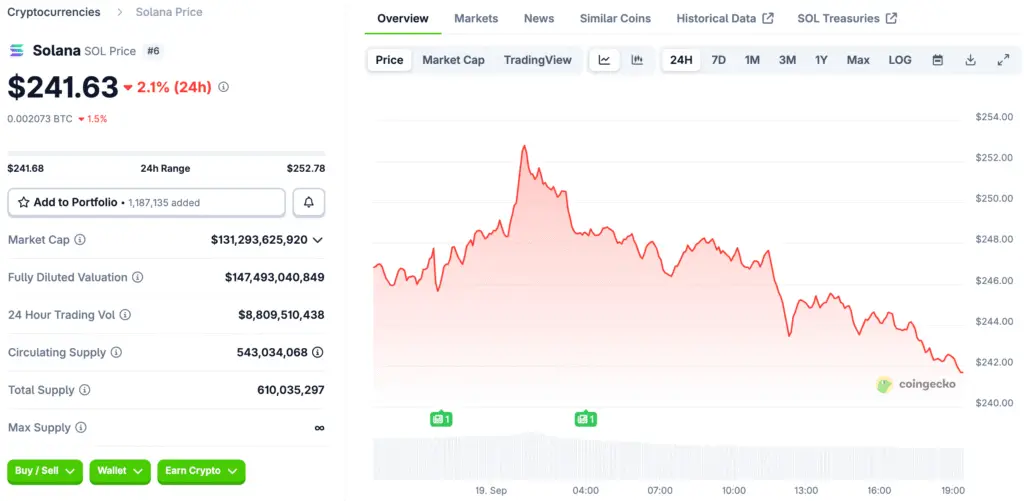Introduction to Solana Treasury Adoption Trends
Solana treasuries turn corporate reserves into active assets by combining price appreciation exposure with staking yields and validator revenues. Companies use SOL to diversify their portfolios, stake their assets in a flexible way, and stay in line with blockchain innovation strategies in growing institutional ecosystems.
More and more public companies are putting money into Solana treasuries, which shows that they believe the company’s long-term growth will continue. These strategies mix old-fashioned investment ideas with new ideas from decentralized finance. This shows how Solana’s role in capital markets is growing quickly.

Core Strategies: Direct Purchases, Staking, and Validator Operations
One simple way is to directly accumulate SOL and then stake it on the blockchain to get regular yield rewards. For example, Upexi staked almost all of its two million SOL tokens and made about sixty-five thousand dollars a day from regular network validation rewards.
Validator node operations give you more control over your infrastructure and may lead to higher returns on delegated stakes. SOL Strategies expanded its operations to handle more than 3.6 million SOL under delegation, which included a lot of institutional participation from ARK Invest.
Liquid Staking and Treasury Flexibility
Liquid staking models give out tokens that represent staked positions. This makes the market more liquid while still allowing users to earn yield through Solana’s ecosystem. DeFi Development was the first to do this with dfdvSOL, which kept the treasury’s liquidity and flexibility while efficiently compounding staking rewards across many deployment opportunities.
This model makes capital more efficient by letting staked assets be used as collateral or moved to other yield strategies. Liquid staking integration changes how companies manage their treasury by allowing them to optimize their yields, keep their cash flow stable, and deploy their assets in a dynamic way all at the same time.
Recommended Article: Solana Mirrors BNB Rally As Breakout Targets Fresh Record Highs
Governance and Transparency Practices
Corporate treasuries stress governance frameworks to handle Solana holdings well with clear disclosures. DeFi Development keeps track of treasury growth by using SOL Per Share metrics, which directly link shareholder value to staking performance outcomes that are published every three months.
Like SOL Strategies, Upexi also reports validator revenues, and it adds staking yields to net asset valuation multiples. These rules for governance build trust among investors, encourage openness, and make sure that corporate treasuries are seen as trustworthy in both the crypto and traditional equity markets at the same time.
Leading Companies in Solana Treasury Adoption
Forward Industries quickly became the biggest holder of the SOL treasury after buying more than 6.8 million tokens with a PIPE worth $1.65 billion. Upexi also raised a lot of money, getting more than two million SOL while using staking strategies that gave them steady returns.
DeFi Development used liquid staking technology and partnerships with validators to grow its treasury to more than two million SOL. Sharps Technology recently switched to using Solana treasury, getting more than two million SOL through private placements backed by big institutional investors.
Advantages and Challenges for Corporate Growth
Solana treasuries give you two ways to make money: they can go up in value and pay you interest. Solana treasuries are operationally productive assets with ongoing revenue, unlike Bitcoin reserves. This yield offset volatility and helped the value of the treasury grow.
But there are still risks. Corporate treasuries have to deal with unclear rules, penalties for validator slashing, the need for operational infrastructure, and the fact that fair value accounting rules can change. There are fewer risk management tools and thinner derivatives, which makes treasury exposure much higher.
Public Companies Provide New Access to Solana
Public companies like Forward Industries, Upexi, and DeFi Development Corp. that hold large Solana treasuries give mainstream investors indirect exposure. Equity shares give you a regulated way to invest in the growth of the Solana ecosystem through treasury holdings, validator revenues, and staking yield strategies.
In Canada and Europe, there are Solana ETFs that offer different ways to get exposure. There are also global funds that offer proof-of-stake baskets that are spread out. These make it easier to get to, while retail investors carefully weigh the risks, taking into account Solana’s volatility, regulatory uncertainty, and the fact that there aren’t many institutional hedging mechanisms overall.
Solana’s Corporate Treasuries Signal a Shift from Bitcoin
The growth of Solana treasuries shows that businesses are open to trying new ways to manage their balance sheets besides Bitcoin. With a wide range of models for staking, validator operations, and liquid staking integrations, Solana treasuries are a dynamic new area for institutional blockchain adoption.
Forward Industries’ billion-dollar investment in Solana treasuries is leading the way as more companies join the trend. As Solana’s ecosystem grows quickly, corporate treasuries are set to become a major source of growth, fundamentally changing how institutions invest in digital assets.



















